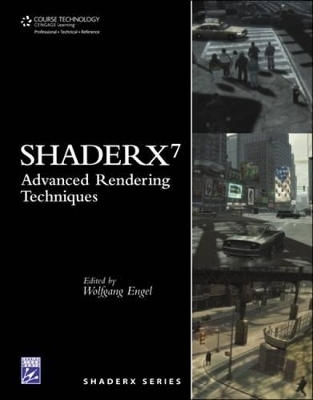
ShaderX7 : Advanced Rendering Techniques
Charles River Media
978-1-58450-598-3 (ISBN)
- Titel ist leider vergriffen;
keine Neuauflage - Artikel merken
Welcome to ShaderX7:Advanced Rendering Techniques, the latest volume in the cuttingedge, indispensable series for game and graphics programmers.This all-new volume is packed with a collection of insightful techniques, innovative solutions to common problems, and practical tools and tricks that provide you with a complete shader programming toolbox. Every article was developed from the research and experiences of industry pros and edited by shader experts, resulting in unbiased coverage of all hardware and developer tools. ShaderX7 provides coverage of the vertex and pixel shader methods used in high-end graphics and game development.These state-of-the-art, ready-to-use solutions will help you meet your daily programming challenges and bring your graphics to a new level of realism.This collection offers time-saving solutions to help you become more efficient and productive, and is a must-have reference for all shader programmers.
Wolfgang is working in Rockstar's core technology group as the lead graphics programmer. He is the editor of the ShaderX books, the author of several other books and loves to talk about graphics programming. He is also a MVP DirectX since July 2006 and active in several advisory boards in the industry.
Part I: Geometry Manuipulation 1.1 Scalar to Polygonal: Extracting Isosurfaces Using Geometry Shaders 1.2: Fast-High Quality Rendering with Real-Time Tessellation on GPUs 1.3: Dynamic Terrain Rendering on GPUs Using Real-Time Tessellation 1.4: Adaptive Re-Meshing for Displacement Mapping 1.5: Fast Tessellation of Quadrilateral Patches for Dynamic Levels of Details Part II: Rendering Techniques 2.1: Quick Noise for GPUs 2.2: Efficient Soft Particles 2.3: Simplified High-Quality Anti-Aliased Lines 2.4: Fast Skin Shading 2.5: An Efficient and Physically Plausible Real-Time Shading Model 2.6: Graphics Techniques in Crackdown 2.7: Deferred Rendering Transparency 2.8: Deferred Shading with Multisampling Anti-Aliasing in DirectX 10 2.9: Light-Indexed Deferred Rendering Part III: Image Space 3.1: Efficient Post-Processing with Importance Sampling 3.2: Efficient Real-Time Motion Blur for Multiple Rigid Objects 3.3 Real-Time Image Abstraction by Directed Filtering Part IV: Shadows 4.1: Practical Cascaded Shadow Maps 4.2: A Hybrid Method for Interactive Shadows in Homogeneous Media 4.3: Real-Time Dynamic Shadows for Image-Based Lighting 4.4: Facetted Shadow Mapping for Large Dynamic Game Environments Part V: Enironmental Effects 5.1: Dynamic Weather Effects 5.2: Interactive Hydraulic Erosion on the GPU 5.3: Advanced Geometry for Complex Sky Representation Part VI: Global Illumination Effects 6.1: Screen-Spcae Ambient Occlusion 6.2: Image-Space Horizon-Based Ambient Occlusion 6.3: Deferred Occlusion from Analytic Surfaces 6.4: Fast Fake Global Illumination 6.5: Real-Time Subsurface Scattering Using Shadow Maps 6.6: Instant Radiosity with GPU Photon tracing and Approxiate Indirect Shadows 6.7: Variance Methods for Screen-Space Ambient Occlusion 6.8: Per-Pixel Ambient Occlusion Using Geometry Shaders Part VII: Handheld Devices 7.1: Optimizing Your First OpenGL ES Application 7.2: Optimzed Shaders for Advanced Graphical User Interfaces 7.3: Facial Ainimation for Mobile GPUs 7.4: Augmented Reality on Mobile Phones Part VIII: 3D Engine Design Overview 8.1: Cross-PlatformRendering Thread: Design and Impementation 8.2: Advanced GUI System for Games 8.3: Game-Engine-Friendly Occlusion Culling 8.5: Designing a Renderer for Multiple Lights; The Light Pre-Pass Renderer 8.6: Light Pre-Pass Renderer: Using the CIE Luv Color Space 8.7: Elemental Engine II Part IX: Beyond Pixels and Triangles 9.1: Sliced grid: A Memory and Computatioanlly Efficient Data Structure for Particle-Based Simulation on the GPU 9.2: Free-Viewpoint Video on the GPU 9.3: A Volue Shader for Quantum Voronoi Diagrams Inside the 3D Bloch Ball 9.4: Packing Arbitrary Bit Fields into 16-Bit Floating-Point Render Targets in DirectX 10 9.5: Interactive Image Morphing Using Thin-Plate Spline
| Reihe/Serie | ShaderX Series |
|---|---|
| Verlagsort | Hingham |
| Sprache | englisch |
| Maße | 191 x 234 mm |
| Gewicht | 1815 g |
| Themenwelt | Informatik ► Software Entwicklung ► Spieleprogrammierung |
| ISBN-10 | 1-58450-598-2 / 1584505982 |
| ISBN-13 | 978-1-58450-598-3 / 9781584505983 |
| Zustand | Neuware |
| Informationen gemäß Produktsicherheitsverordnung (GPSR) | |
| Haben Sie eine Frage zum Produkt? |